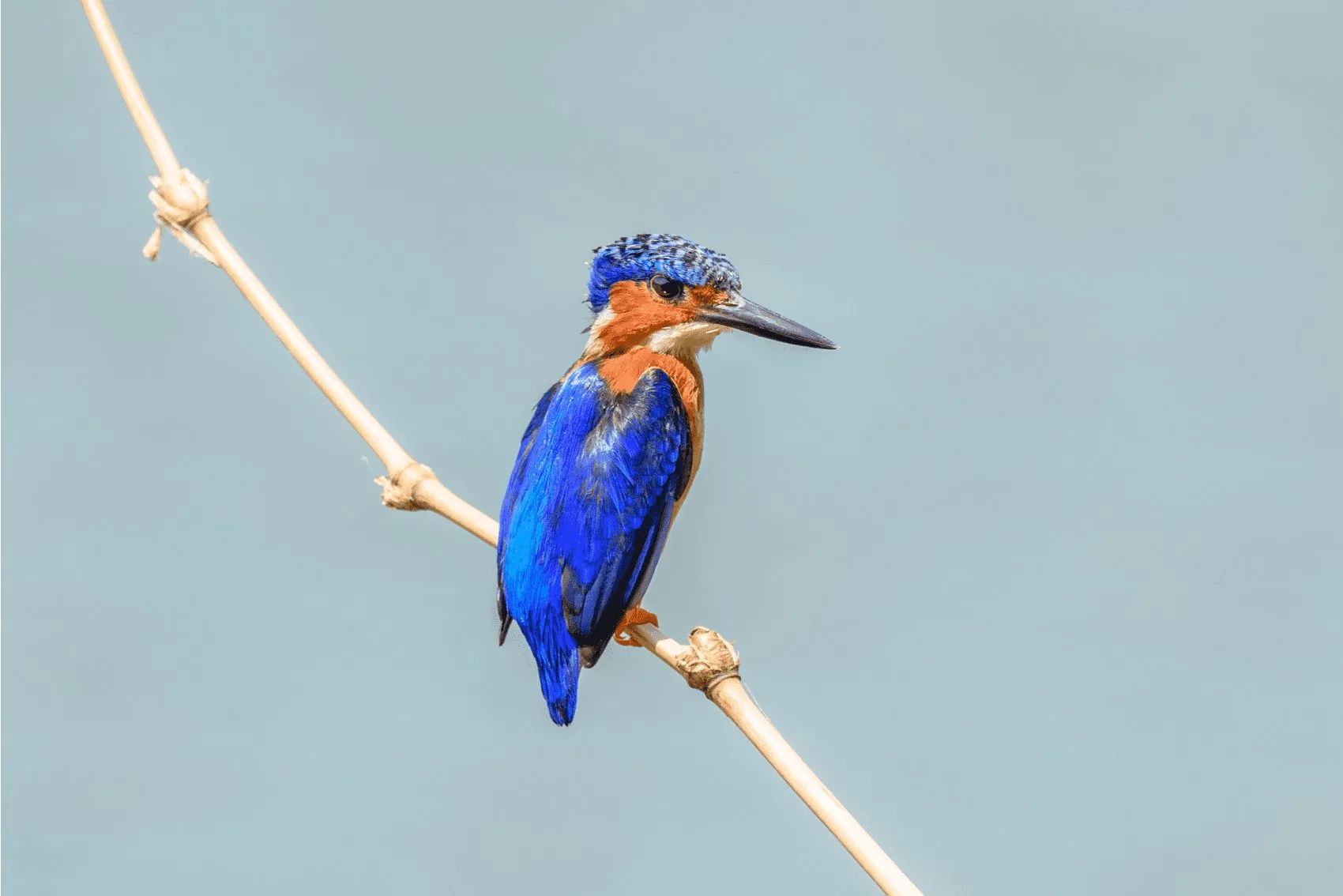The Ambatovaky Special Reserve is considered as one of the most important protected areas in Madagascar because of the large number of endangered and vulnerable bird and lemur species that call it home.
Overview
Nestled between the Simianona and Marimbona rivers, the Ambatovaky Special Reserve stretches for about 60,050 hectares in the Soanierana-Ivongo District of Madagascar’s northeastern tip.
It is mainly classified as a tropical rainforest and features an assortment of terrains and land formations such as ridges, valleys and hills that abound with deciduous trees.
Several scattered thickets of sclerophyll vegetation also blanket the area. The Ambatovaky Special Reserve is deemed by conservationists as a crucial site for vulnerable and endangered birds.
This is because it’s only one of the places in the world where some of the rarest avian species live. The most popular species are the Red-tailed Newtonia (Newtonia fanovanae) and the Madagascar kingfisher (Corythornis vintsioides).
But the park is also home to the White-breasted Mesite (Mesitornis variegata), populations of the Brown mesite (Mesitornis unicolor), the Madagascar cuckoo-hawk (Aviceda madagascariensis), the Madagascan cuckooshrike (Ceblepyris cinereus) and the Madagascan serpent eagle (Eutriorchis astur).
The Ambatovaky Special Reserve is also a refuge for the Perrier’s sifaka (Propithecus perrieri) that is already categorized by the International Union for Conservation of Nature (IUCN) as critically endangered.
These along with the red-bellied lemur (Eulemur rubriventer), the Black-and-white ruffed lemur (Varecia variegata) and the Babakoto (Indri indri).
Established in October 28, 1958, the Ambatovaky Special Reserve is becoming a hub for scientific study for its abundance in endemic biodiversity.
Other than its bird and lemur residents, the reserve also has an extensive catalog of 221 species of plants, 34 species of fish and 113 species of amphibians and reptiles.
The fringes of the reserve are inhabited by locals whose total population of 29,489 is spread over 57 villages and communes. Most of these inhabitants belong to the Betsimisaraka tribe.
Highlights
The Birds and Lemurs
The Ambatovaky Special Reserve was particularly created more than five decades ago because of the rare bird and lemur species that live inside it.
One of its winged denizens, the Red-tailed Newtonia, was thought to be already extinct when it was inadvertently spotted in the reserve.
Scientists declared its “rediscovery” in 1989. The Madagascan serpent eagle, recognized as one of the world’s rarest raptors, was also observed nesting in the area.
The last sighting of this bird was documented during the 1930’s, until it was seen in the reserve’s expanse. As for the Perrier’s sifaka, experts relate that there are only 125 mature specimens living in the reserve at present.
Flaunting a distinct jet-black fur as well as ears and eyes that have a mysterious red-orange glow, it is described as one of the most mysterious lemurs in Madagascar.
What makes the Perrier’s sifaka really interesting is that even though its diet primarily consists of a variety of flowers, fruits and leaves, this lemur can sometimes be seen tucking into dirt.
Scientists believe that it is probably supplementing its nutritional levels with the minerals found in the soil.
The Iampirano and the Sandrangato Rivers
The rivers of Iampirano and the Sandrangato flow through the Ambatovaky Special Reserve. Both are considered as main sources of water for the plants and animals living in the area.
Collectively featuring 34 species of fish between them, the Iampirano and the Sandrangato rivers also serve as key wading and hunting areas for the birds and mammals in the reserve, like the Malagasy or striped civet (Fossa fossana) and the cat-like Fossa (Cryptoprocta ferox).
Recommended Activities
The Ambatovaky Special Reserve can be described as one of the best hiking and bird-watching sites that you can visit if you’re looking to experience nature at its finest.
But there’s a very big catch that you should first know about. Apart from being extremely inaccessible, there are also no modern accommodations that you can book in and around the reserve.
This means that if you do decide to go there, you can expect the experience to be as rough and hardcore as it gets.
If these conditions don’t intimidate you in any way at all, then you should go ahead and include this place in your list of holiday destinations to check out.
Hike the reserve’s interesting trails.
One of the reasons why the Ambatovaky Special Reserve is an awesome hiking spot is its unique variety of terrains and trails.
The area features an array of slopes, descents and peaks that will keep you engaged as you go along. Tourists who have already braved the reserve’s trails share that the scenery is also constantly changing during the hike.
One minute you’re passing through a patch of sclerophyll thicket, then you’ll just realize you are already in a dense deciduous forest the next.
Catch a glimpse of some of the world’s rarest birds and lemurs.
The Ambatovaky Special Reserve is known as a bastion for the Madagascan serpent eagle, the Perrier’s sifaka, the Madagascar cuckoo-hawk and the Babakoto — just to name a few of its diverse fauna — that are not just extremely rare but can also be found nowhere else in the world.
Furthermore, you can also get to see some uncommon butterfly species such as the Madagascan friar (Amauris nossima) and the Mangoura swallowtail (Papilio mangoura) in the Ambatovaky Special Reserve’s expanse.
These butterflies are known for their distinct color patterns that resemble exquisite weave work.
Important Reminders
Start off early
Hiking the Ambatovaky Special Reserve is best started early in the morning, between 8 AM to 8:30 AM, when the forest is just starting to become alive with the sounds and movements of its animal denizens.
Besides catching sight of birds hunting and feeding on fruits, nuts and insects, you are also going to see some lemurs hanging out in the trees or socializing on the branches, particularly when you arrive at the reserve’s thickly-forested areas.
While animal activity tends to significantly lessen during the late mornings, you can still spot a lot of birds bathing or wading in the waters of the Iampirano and the Sandrangato rivers.
The reserve is rather still and quiet — save from the odd chirp and buzz or two of insects — from noon to early afternoon. Heightened animal activity usually resumes in the late afternoon.
Planning your outfit
Unlike some of its counterparts like the Andohahela National Park and the Tsimanampetsotsa National Park, the areas in and around the Ambatovaky Special Reserve do not feature a spiny forest.
This means you won’t have to worry about stinging plants and sharp rocks while you’re hiking its trails.
If you’re planning to tour the reserve, make sure you wear hiking gear that are made from nylon or polyester that don’t just dry quickly but won’t also retain as much moisture.
You’ll also need a good pair of hiking shoes with decent traction since some parts of the trail can be either slippery or filled with loose rocks.
Having a reliable rain jacket in your Ambatovaky Special Reserve hiking ensemble is also a must since it is not uncommon for the area to experience random rain showers throughout the day.
Bringing along sun protection and bug repellent is also recommended.
Best Time to Visit
The ideal time to visit the Ambatovaky Special Reserve is between the months of April and October when the overall climate in the area is dry yet cool.
While there may still be scattered rain showers in the reserve during this time, they won’t be as long and vigorous compared to those that take place during Madagascar’s wet season.
According to the local tour guides, the dry season is the best time to visit the reserve if you’re looking to see some lemurs since they are going to be more active and visible.
On the other hand, you should go for the months between November and March when visiting the Ambatovaky Special Reserve if bird-watching is on top of your to-do list.
How to Get There
The Ambatovaky Special Reserve is one of the most inaccessible places in Madagascar since there is no direct route or access road that passes right through it.
This is the biggest reason why it isn’t as popular compared to its counterparts in the island country.
First route
However, if your mind is set on making this reserve your next holiday destination, the most straightforward route you can go for is by travelling from Toamasina to Soanoerana-Ivongo by bus or via taxi.
You also have the option of hiring a private car if you are bringing along a lot of gear. If you’re taking the bus, the usual travel time is around 3 hours and 30 minutes.
If you’re going by taxi or car, the usual travel time is 2 hours and 45 minutes. When you arrive in Soanoerana-Ivongo, go to the Marimboana River and hire a boat that will take you to the village of Fotsialana.
This can take as much as 4 hours depending on the weather. Once you’re in Fotsialana, you’ll need to hike a full day to reach the entrance of the reserve.
Second route
Alternatively, there is another route that you can go for to reach the Ambatovaky Special Reserve if you’re looking to take adventure up a notch.
When you reach Soanoerana-Ivongo, you can either ride in a canoe or hike to reach the town of Ambodiriana.
The usual travel time is 5 hours, but can take longer during the wet season. From Ambodiriana, you will need to hike three (3) days to reach the reserve’s entrance.
Important things to keep in mind
The entrance fee to the Ambatovaky Special Reserve is 45,000 AR for adult tourists and 25,000 AR for children. The reserve usually opens at 8 AM and closes at 4 PM. You’d have to register at the gate first before being allowed in the area.
Where to Stay
Given the Ambatovaky Special Reserve’s remoteness, there are no available hotels and similar establishments that you can stay in when you visit the place.
The closest accommodations that you can book are located in the port city of Toamasina, also known as Tamatave.
La Maison (Résidence Magali)
The La Maison (Résidence Magali) has gathered quite a following over the years for its fusion of homey atmosphere and modern creature comforts.
Set right in the middle of the city, it offers cozy rooms as well as easy access to the main areas of interest in Toamasina without having the need to travel too far. Most of them are within walking distance, too.
La Maison’s restaurant is also quite popular for its seafood selections like the breaded fish and calamari entrées that are prepared with fresh ingredients daily.
According to guests who have already stayed in this hotel, the staff are super friendly and the service is impressive.
You can reach out to La Maison (Résidence Magali) at:
- Tel: +261 32 05 643 60
- Address: 501 Rue Victor Hugo, Toamasina, Madagascar
- Website: facebook.com/lamaison501
- Email: lamaison@lamaison.com
Hotel H1
The Hotel H1 is highly recommended for tourists who’d like to grab decent accommodations without overspending.
While this hotel doesn’t have the modern décor and furnishings most of its counterparts in Toamasina flaunt, its simple ambiance and tranquility will make your stay here truly restful.
Hotel H1 is also very near to the popular beach resorts and restaurants in the area as well as the Toamasina Municipal Stadium.
You can reach out to Hotel H1 at:
- Tel: +261 20 53 316 03
- Address: 5 Rue Guynemer, Toamasina 501, Madagascar



